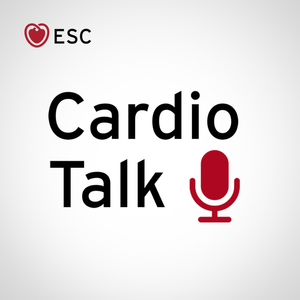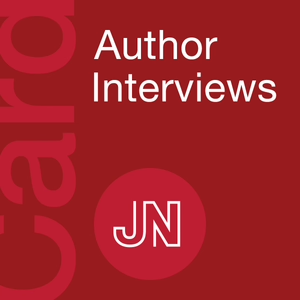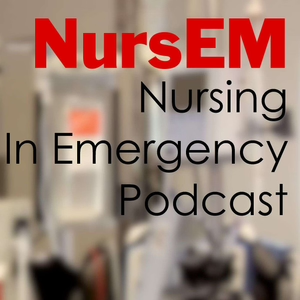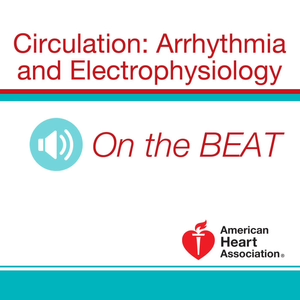
Circulation: Arrhythmia and Electrophysiology March 2019 Issue
03/25/19 • 15 min
Dr Paul Wang: Welcome to the monthly podcast "On the Beat" for Circulation: Arrhythmia, and Electrophysiology. I'm Dr Paul Wang, Editor-in Chief, with some of the key highlights from this month's issue.
In our first manuscript, Marie Bayer Elming and associates, examined whether the right ventricular ejection fraction can identify patients with non-ischemic systolic heart failure, more likely to benefit from ICD implantation. The Danish study, to assess the efficacy of ICDs in patients with non-ischemic systolic heart failure, on mortality, the Danish study, randomized patients with non-ischemic systolic heart failure to ICD our control. In 239 patients with interpretable cardiovascular magnetic resonance images, the right ventricular volume and ejection fraction was measured. Right ventricular ejection fraction was an independent predictor of all-cause mortality, with a hazard ration 1.34 per 10% absolute decrease in our right ventricular ejection fraction. P=0.02. There is statistically significant interaction between right ventricular ejection fraction and the effect of ICD implantation. P=0.001. ICD implantation significantly reduced all-cause mortality in patients with right ventricular systolic dysfunction. Hazard ratio 0.41, but not in patients without right ventricular systolic dysfunction.
Thus, in this post-hoc analysis of the Danish trial, ICD therapy was associated with survival benefit in patients with bi-ventricular heart failure.
In our next paper, Dawn Pedrotty and Volodymyr Kuzmenko and associates, have proposed a concept of using a stretchable, flexible, bio patch, with conductive properties, to attempt to restore conduction across regions in which activation is disrupted. They use carbon nanotube patches, composed of nanofibrillated cellulose, in single wall carbon nanotube ink, 3-D printed in conductive patterns onto bacterial nanocellulose.
Electro anatomic mapping was performed on normal epicardium and repeated over surgically disruptive epicardium, and finally with the patch applied passively. The patch resulted in restored conduction based on mapping.
In our next paper, Ayman Hussein and colleagues developed a fully automated platform to collect patient reported outcomes in a prospective cohort of atrial fibrillation ablation. Two thousand one hundred and seventy-five patients were eligible to receive 10,903 patient reported outcome assessment invitations. More follow up assessments were obtained with automated patient reported outcomes in routine follow-up, compared with routine follow up alone, P > 0.001, which allowed for longer duration of follow up, 378 vs 217 days. By automated patient reported outcomes, a large number of disease specific variables were collected and showed improvement in quality of life. Baseline median AF symptom severity score of 12 and ranged between 2 and 3 on subsequent assessments, P > 0.0001. This improvement was also true for each of the atrial fibrillation symptom severity score components. In patient reported outcomes, there was a significant reduction in atrial fibrillation burden, such as frequency and duration episodes and associated healthcare utilization including emergency visits and hospitalizations after the ablation procedures.
In our next paper, Nicolas Johner, Dipen Shah, and associates, examined the role of post pacing intervals shorter than tachycardia cycling during entrainment mapping. The author studied 24 non-cavotricuspid isthmus dependent macro oriented atrial flutters in 19 consecutive patients. High density electro anatomic activation maps were acquired with a 64-electrode basket catheter of 102 entrainment mapping sites. Post pacing interval difference less than 30 was observed at 72 sites on complete maps of 24 atypical atrial flutters compared to sites with the difference in post pacing intervals 0 to 30, with 45 sites difference in the post pacing interval less than 0 at 27 were more commonly located within isthmuses less than 15mm wide and more frequently located in within 5mm of the leading wave front. It also exhibited slower local conduction, lower voltages in more frequently fractioned electrograms. The authors concluded that in atrial flutter, sites with differences with the post pacing interval are markers of limited width critical isthmuses with slower conduction velocity, while sites with difference in post pacing interval 0 to 30ms are often not in close proximity to the reentrance circuit. Virtual electrode simultaneous down and up stream, antidromic capture of a confined isthmus of slow conduction can explain a difference in the post pacing interval less than 0.
In the next paper, José Manuel Alfonso-Almazán, and associates studied the safety and efficacy parameters associated with catheter-based radiofrequency delivery at the root of the aorta and pulmonary artery. The author studied 34 pigs undergoing in vivo catheter based ablation using continuous...
Dr Paul Wang: Welcome to the monthly podcast "On the Beat" for Circulation: Arrhythmia, and Electrophysiology. I'm Dr Paul Wang, Editor-in Chief, with some of the key highlights from this month's issue.
In our first manuscript, Marie Bayer Elming and associates, examined whether the right ventricular ejection fraction can identify patients with non-ischemic systolic heart failure, more likely to benefit from ICD implantation. The Danish study, to assess the efficacy of ICDs in patients with non-ischemic systolic heart failure, on mortality, the Danish study, randomized patients with non-ischemic systolic heart failure to ICD our control. In 239 patients with interpretable cardiovascular magnetic resonance images, the right ventricular volume and ejection fraction was measured. Right ventricular ejection fraction was an independent predictor of all-cause mortality, with a hazard ration 1.34 per 10% absolute decrease in our right ventricular ejection fraction. P=0.02. There is statistically significant interaction between right ventricular ejection fraction and the effect of ICD implantation. P=0.001. ICD implantation significantly reduced all-cause mortality in patients with right ventricular systolic dysfunction. Hazard ratio 0.41, but not in patients without right ventricular systolic dysfunction.
Thus, in this post-hoc analysis of the Danish trial, ICD therapy was associated with survival benefit in patients with bi-ventricular heart failure.
In our next paper, Dawn Pedrotty and Volodymyr Kuzmenko and associates, have proposed a concept of using a stretchable, flexible, bio patch, with conductive properties, to attempt to restore conduction across regions in which activation is disrupted. They use carbon nanotube patches, composed of nanofibrillated cellulose, in single wall carbon nanotube ink, 3-D printed in conductive patterns onto bacterial nanocellulose.
Electro anatomic mapping was performed on normal epicardium and repeated over surgically disruptive epicardium, and finally with the patch applied passively. The patch resulted in restored conduction based on mapping.
In our next paper, Ayman Hussein and colleagues developed a fully automated platform to collect patient reported outcomes in a prospective cohort of atrial fibrillation ablation. Two thousand one hundred and seventy-five patients were eligible to receive 10,903 patient reported outcome assessment invitations. More follow up assessments were obtained with automated patient reported outcomes in routine follow-up, compared with routine follow up alone, P > 0.001, which allowed for longer duration of follow up, 378 vs 217 days. By automated patient reported outcomes, a large number of disease specific variables were collected and showed improvement in quality of life. Baseline median AF symptom severity score of 12 and ranged between 2 and 3 on subsequent assessments, P > 0.0001. This improvement was also true for each of the atrial fibrillation symptom severity score components. In patient reported outcomes, there was a significant reduction in atrial fibrillation burden, such as frequency and duration episodes and associated healthcare utilization including emergency visits and hospitalizations after the ablation procedures.
In our next paper, Nicolas Johner, Dipen Shah, and associates, examined the role of post pacing intervals shorter than tachycardia cycling during entrainment mapping. The author studied 24 non-cavotricuspid isthmus dependent macro oriented atrial flutters in 19 consecutive patients. High density electro anatomic activation maps were acquired with a 64-electrode basket catheter of 102 entrainment mapping sites. Post pacing interval difference less than 30 was observed at 72 sites on complete maps of 24 atypical atrial flutters compared to sites with the difference in post pacing intervals 0 to 30, with 45 sites difference in the post pacing interval less than 0 at 27 were more commonly located within isthmuses less than 15mm wide and more frequently located in within 5mm of the leading wave front. It also exhibited slower local conduction, lower voltages in more frequently fractioned electrograms. The authors concluded that in atrial flutter, sites with differences with the post pacing interval are markers of limited width critical isthmuses with slower conduction velocity, while sites with difference in post pacing interval 0 to 30ms are often not in close proximity to the reentrance circuit. Virtual electrode simultaneous down and up stream, antidromic capture of a confined isthmus of slow conduction can explain a difference in the post pacing interval less than 0.
In the next paper, José Manuel Alfonso-Almazán, and associates studied the safety and efficacy parameters associated with catheter-based radiofrequency delivery at the root of the aorta and pulmonary artery. The author studied 34 pigs undergoing in vivo catheter based ablation using continuous...
Previous Episode

Circulation: Arrhythmia and Electrophysiology February 2019 Issue
Dr Paul Wong: Welcome to the monthly podcast on the beat for Circulation: Arrhythmia and Electrophysiology. I'm Dr Paul Wong, Editor-in Chief with some of the key highlights from this month's issue.
This month's issue is dedicated to a new exciting topic, His bundle pacing. His bundle pacing is designed to achieve a more physiological human dynamic response than right ventricular pacing alone, which may be needed in patients with AV conduction abnormalities. In our first paper, Marek Jastrzebski and associates examined whether program stimulation may be used to distinguish nonselective His bundle capture from right ventricular myocardial capture. Premature beats were introduced at 10 millisecond steps during intrinsic rhythm, and also after a drive train of 600 milli seconds. The longest coupling interval that resulted in an abrupt change in the QRS morphology was considered equal to the effective refractory period of the His bundle or right ventricular myocardium.
Program His bundle pacing was performed from 50 different sites in 32 patients. In 34 out of 36 cases of nonselective His bundle pacing, the right ventricular myocardial effective refractory period was shorter than the His bundle effective a refractory period. 271 milliseconds versus 353 milliseconds, P less than 0.0001. Program His bundle pacing using a drive train typically resulted in an abrupt change of the QRS morphology. From nonselective His bundle to right ventricular myocardial QRS 34 out of 36 cases, or to selective His bundle QRS in two out of 36 cases. Program His bundle pacing deliver during native conduction resulted in obtaining selective His bundle QRS in 20 out of 34 patients, and right ventricular myocardial QRS in 14 out of 34 of the nonselective His bundle cases.
In right ventricular myocardial only pacing cases, so-called false nonselective His bundle pacing, and equals 14. Such responses were not observed. The QRS morphology remained stable. Therefore His bundle pacing correctly diagnosed, using programs stimulation, all nonselective His bundle cases in all right ventricular myocardial pacing cases.
In our next paper Aditya Saini and associates sought to determine whether the device electric cam can be used to differentiate between selective, nonselective His bundle pacing, and right ventricular septal capture. In 148 consecutive patients, His bundle pacing was performed. The near field ventricular electrogram morphology, the near field ventricular electrogram time to peak and the far field ventricular electrogram QRS duration were recorded while pacing the His bundle was simultaneous 12 lead ECG rhythm strips. The mean baseline QRS duration was 108 milliseconds, with QRS duration greater than 120 milliseconds in 57 or 39% of patients, including 27 with right bundle branch block, 18 with left bundle branch block, and 12 with an IVCD.
Selective His bundle pacing was noted in 54 or 36% of patients. A positive near field ventricular electrogram time to peak, and a near field ventricular electrogram time to peak of greater than 40 milliseconds were highly sensitive, 94% and 93% respectively, and specific 90% and 94% for selective His bundle pacing, irrespective of baseline QRS duration. All three parameters including positive near field ventricular electrogram time to peak, the near field ventricular electrogram time to peak greater than 40 milliseconds, and far field ventricular electrogram QRS duration less than 120 milliseconds had high predictive negative predictive value, 97%, 95%, and 92%. Therefore, a novel device-based algorithm for a selective His bundle pacing was proposed.
Electrogram transitions correlated with ECG transitions during threshold testing, and can accurately predict and differentiate between selective His bundle pacing, nonselective His bundle pacing, and right ventricular septal pacing with a cumulative positive predictive value of 91% and 100% in patients with a baseline QRS duration of less than 120 milliseconds.
In the next paper, Pugazhendhi Vijayaraman and associates examined whether Cardiac Resynchronization Therapy could be optimized by sequential His bundle pacing followed by left ventricular pacing, which the authors called His optimize CRT or hot CRT. Hot CRT was successfully achieved in 25 of 27 patients. The QRS duration and baseline was 183 milliseconds, and significantly narrowed to 162 milliseconds with biventricular pacing, to 151 milli seconds during His bundle pacing, and further to 120 milliseconds during hot CRT pacing, P less than 0.0001. During a mean follow-up of 14 months, left ventricular ejection fraction improved from 24 to 38%, P less than 0.0001, and New York Heart Association Functional Class changed from 3.3 to 2.04. 21 out of the 25 patients, or 84% were clinical responders, while 23 of 25, 92% showed echocardiographic response.
In our next paper, Parikshit Sharma and associates compared permanent His...
Next Episode
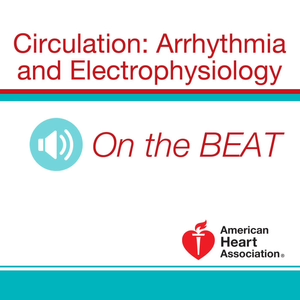
Circulation: Arrhythmia and Electrophysiology April 2019 Issue
Dr Paul Wang: Welcome to the monthly podcast On the Beat for Circulation: Arrhythmia and Electrophysiology. I'm Dr Paul Wang, Editor in Chief, with some of the key highlights from this month's issue.
In our first paper Lucas Boersma and associates examined the final two-year outcome data from 47 centers, in 1,020 patients receiving the left atrial appendage occlusion watchman devices. Their study population had a mean age of 73.4 years, with 311 having prior ischemic stroke or TIA, 153 having prior hemorrhagic stroke, and 318 having prior major bleeding. 49% had a CHAS II vast score of 5 or greater, and 40% had a HAS-BLED score of three or greater. Oral anticoagulation was contraindicated in 72%. During follow up, 161 patients, or 16.4% died, 22 strokes were observed or 1.3 per 100 patient years representing an 83% reduction versus historic data. And 47 major non-procedural bleeding events were observed, or 2.7 per 100 patient years representing a 46% reduction versus historic data.
Device thrombus was observed in 34 patients or 4.1%, and was not correlated to the drug regimen during follow up. P=0.28.
In our next paper, Anish Amin and Associates examined whether high voltage impedance and subcutaneous or SICD system implant position are associated with ventricular fibrillation or VF conversion success with a sub-maximal joule shock. In the SICD investigational device exemption study, a successful conversion test required two consecutive VF conversions at 65 joules in either shock vector. Sub-optimal device position was defined as an inferior electrode or pulse generator, or electrode coil depth of greater than three mm anterior to the sternum, based on chest radiograph. Of 314 patients who underwent SICD implantation, 282 patients were included in this analysis. There were 637 inductions to test defibrillation at 65 joules. 62 conversion failures, or 9.7%, occurred in 42 or 14.9% of patients.
Lower body mass index or BMI, and lower shock impedance, were associated with higher conversion success rate. Whereas white race was associated with lower conversion success rate. Sub-optimal position was more common in obese patients. Inferior electrode and greater distance between the lead and sternum were associated with a higher impedance. When appropriate system position was achieved, conversion failure was not associated with high BMI.
In our next paper, Je-Wook Park and associates examined the left atrial pressure after repeat radiofrequency catheter ablation procedures. Among 1,848 patients who underwent atrial fibrillation or AF catheter ablation, the authors measured the left atrial pressure, LAP, immediately following the transseptal puncture in sinus rhythm in 1,687 patients before De novo ablation, median age 59 years, 72.4% male and 72.8% paroxysmal AF, and in 142 with second procedures. In the same 142 patients, the degree of left atrial stiffness, reflected by LAPP, the difference between LAP peak and LAP nater, was significantly higher in the second procedure than in the De novo procedure. P
If you like this episode you’ll love
Episode Comments
Generate a badge
Get a badge for your website that links back to this episode
<a href="https://goodpods.com/podcasts/circulation-arrhythmia-and-electrophysiology-on-the-beat-94401/circulation-arrhythmia-and-electrophysiology-march-2019-issue-5066066"> <img src="https://storage.googleapis.com/goodpods-images-bucket/badges/generic-badge-1.svg" alt="listen to circulation: arrhythmia and electrophysiology march 2019 issue on goodpods" style="width: 225px" /> </a>
Copy
